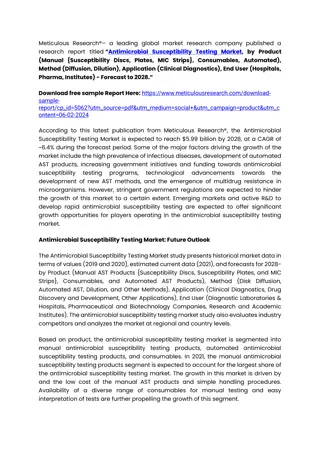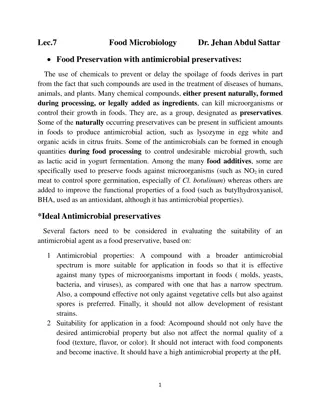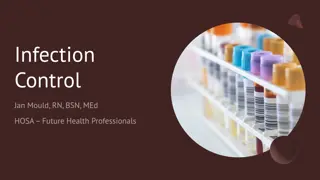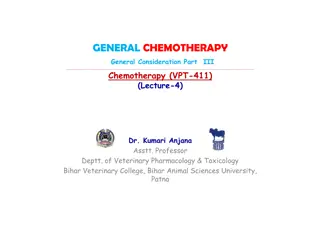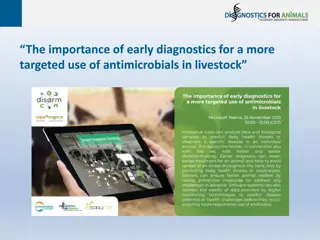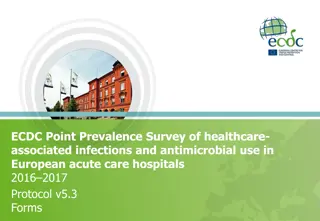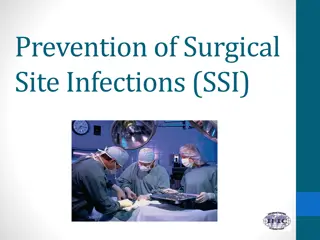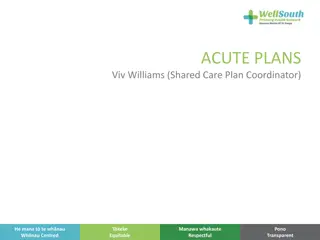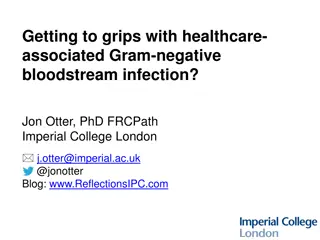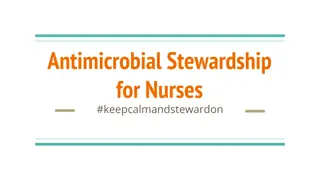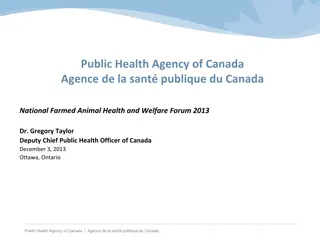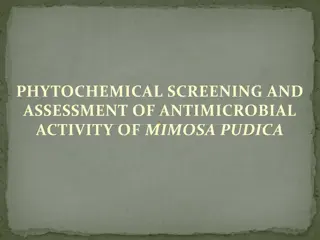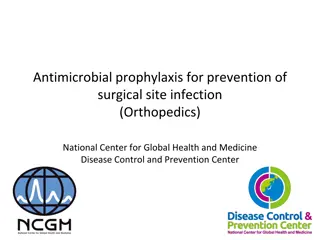Insights into Healthcare-Associated Infections and Antimicrobial Use in Acute Care Settings
This report presents findings from a Point Prevalence Survey (PPS) on Healthcare-Associated Infections (HAI) and Antimicrobial Use (AMU) in acute care, highlighting the prevalence rates, distribution of infections, changes in infection rates, and patterns of antimicrobial consumption across European countries. The data underscores the impact of inappropriate antimicrobial use on antimicrobial resistance and healthcare outcomes, emphasizing the importance of adherence to guidelines in reducing consumption and improving patient care.
Download Presentation

Please find below an Image/Link to download the presentation.
The content on the website is provided AS IS for your information and personal use only. It may not be sold, licensed, or shared on other websites without obtaining consent from the author.If you encounter any issues during the download, it is possible that the publisher has removed the file from their server.
You are allowed to download the files provided on this website for personal or commercial use, subject to the condition that they are used lawfully. All files are the property of their respective owners.
The content on the website is provided AS IS for your information and personal use only. It may not be sold, licensed, or shared on other websites without obtaining consent from the author.
E N D
Presentation Transcript
Point prevalence survey (PPS) of healthcare associated infections (HAI) & antimicrobial use (AMU) in acute care Mark McConaghy, Dr Muhammad Sartaj, Dr Bronagh Clarke, Dr Tony Crockford PHA Health protection nurses, Trust PPS coordinators and local acute teams.
Context Risk; >4 million people in Europe get a healthcare- associated infections every year, around 37k die as a direct result of the infection. Inappropriate antimicrobial use is a key driver of antimicrobial resistance; understanding the indications and adherence to guidelines is important to reduce consumption and respond to targets e.g. O Neill Infection means more pressure on the system extra cost, inpatient days, re-operations, bed availability, activity displacement, morbidity and mortality Badia J.M. et al Impact of surgical site infection on healthcare costs and patient outcomes: a systematic review in six European countries. Journal of Hospital Infection 96 (2017) 1-15
HAI estimate 1 in 16 versus 1 in 24 Comparable rates of hospital acquired infections in Europe and UK Distribution of infection - Pneumonia (29%), - SSI (17%), - GI (10%) and - BSI (9%) HAI HAI prevalence 2012 prevalence 2017 Country Europe ECDC PPS 6.2 (6.1 - 6.3) 5.5 (4.5 -6.7) England 6.5 (4.8 - 8.8) 6.4 (5.4 -7.6) Scotland 4.9 (4.4 - 5.4) 4.5 (4.0 - 5.0) Wales 4.3 (3.8 - 4.8) 5.5 (5.0 - 6.1) Northern Ireland 4.2 (3.6 - 4.8) 6.1 (5.4 - 6.9)
Changes to infection rates -Pneumonia -Bloodstream, GI also Increased number of SSI (organ/space*) infection types * Significance <0.05
Gram positive (37.3%) - Staph aureus 18.6% [14%] - Enterococcus spp 18.6% [12%] Gram negative Enterobacteriaceae(35.2%) - e-coli 20.6% [8%] Anaerobic bacilli (16.7%) - C. diff 12.7% [8%] Fungi (5.9%) & Gram negative non- enterobateriaceae (4.9%)
PPS 2012 AMU prevalence 29.5% (28.1 30.9) 6 in 20 PPS 2017 AMU prevalence 36.3% (34.8 37.9): 7 in 20
2017 AMU benchmark figure Comparable rates of antimicrobial consumption in Europe and UK AMU prevalence 2012 AMU prevalence 2017 Country Europe ECDC PPS 32.7 (29.4 36.2) 30.5 (29.2 31.9) England (Acute) 34.3 (30.1 39.2) 37.4 (35.3 39.5) Scotland (Acute) 32.3 (30.9 33.8) 35.3 (33.8 36.7) Wales (Acute) 32.7 (31.6 33.9) 34.2 (33.0 35.3) Northern Ireland 29.5 (28.1 30.9) 36.3 (34.8 37.9)
Indication for antimicrobial prescription - Similar distribution 2017 and 2012; majority for community acquired infection, - followed by hospital associated infection and medical and surgical prophylaxis
Route of administration -High proportion of antimicrobials administered paternally; 63% -Comparable figure in Scotland and Wales ~50% -Less IV-oral switching
Top 20 antimicrobials 2012 & 2017 0 50 100 150 200 250 300 350 Piperacillin and tazobactam-J01CR05 Amoxicillin-J01CA04 Co-amoxiclav-J01CR02 Gentamicin-J01GB03 Metronidazole (parenteral)-J01XD01 Flucloxacillin-J01CF05 PPS2012 Teicoplanin-J01XA02 Clarithromycin-J01FA09 PPS2017 Doxycycline-J01AA02 Ciprofloxacin-J01MA02 Meropenem-J01DH02 Nystatin-A07AA02 Sulfamethoxazole and trimethoprim-J01EE01 Metronidazole (oral-rectal)-P01AB01 Benzylpenicillin-J01CE01 Cefuroxime-J01DC02 Trimethoprim-J01EA01 Vancomycin (parenteral)-J01XA01 Ceftriaxone-J01DD04 Fluconazole-J02AC01
Antimicrobial compliant with local policy? percent 0 10 20 30 40 50 60 70 80 90 79.4 Yes 72.7 10.9 No 11.7 2012 9.3 2017 Not assessable 14.4 0.3 Not known 1.3 Not assessable where the antimicrobial is prescribed for medical prophylaxis or local policy is not available for the specific infection being treated or procedure undergone
Top ten most commonly off-policy antibiotics Not to guidelines 50 50 20 16 15 9 9 9 8 8 Total No. prescribed 176 322 177 92 105 87 139 93 75 48 % off guidelines 28.4 15.5 11.3 17.4 14.3 10.3 6.5 9.7 10.7 16.7 Antibiotic Co-amoxiclav Piperacillin-tazobactamW Amoxicillin Clarithromycin W Metronidazole (parenteral) Doxycycline Gentamicin TeicoplaninW MeropenemW Metronidazole (oral- rectal) W = watch group
DiagnosissitewhereAMused Infection Number diagnosed Percent Respiratory tract (pneumonia/bronchitis) 614 35.2 ! (506 pneu & 108 bron) ! ! Gastro 288 16.5 ! Systemic infection 257 14.7 ! Skin/soft tissue/bone/joint 254 14.5 Urinary tract 201 11.5 Eye/ear/nose/throat 57 3.3 Central nervous system 31 1.8 ! Genito-urinary system 27 1.5 ! ! Cardiovascular system 17 1.0 ! !
Classifying antibiotics in the WHO List of essential medicines for optimal use be AWaRe Higher resistance potential. 1st/2nd treatment choice for limited indications 1st/2nd choice Access antibiotics to be widely available, 1200 +7.7% 1000 +27.4% 800 number AMs Antibiotics treated as last resort and used when all alternatives have 600 16% not compliant 400 9% not compliant 200 +14.7% 8% not compliant 0 Access Watch Reserve 2012 2017
Review of antimicrobial order within 72h at ward level?
Finally. Key priorities for regional actions identified in the final report and included in the work plan of the Regional HCAI & AMR Board Individual trust level data was shared with the Trust to identify local priorities and develop local action plans Consideration given to more frequent local PPS style surveys and further development of incidence surveillance systems to strengthen evidence base and monitor change.


